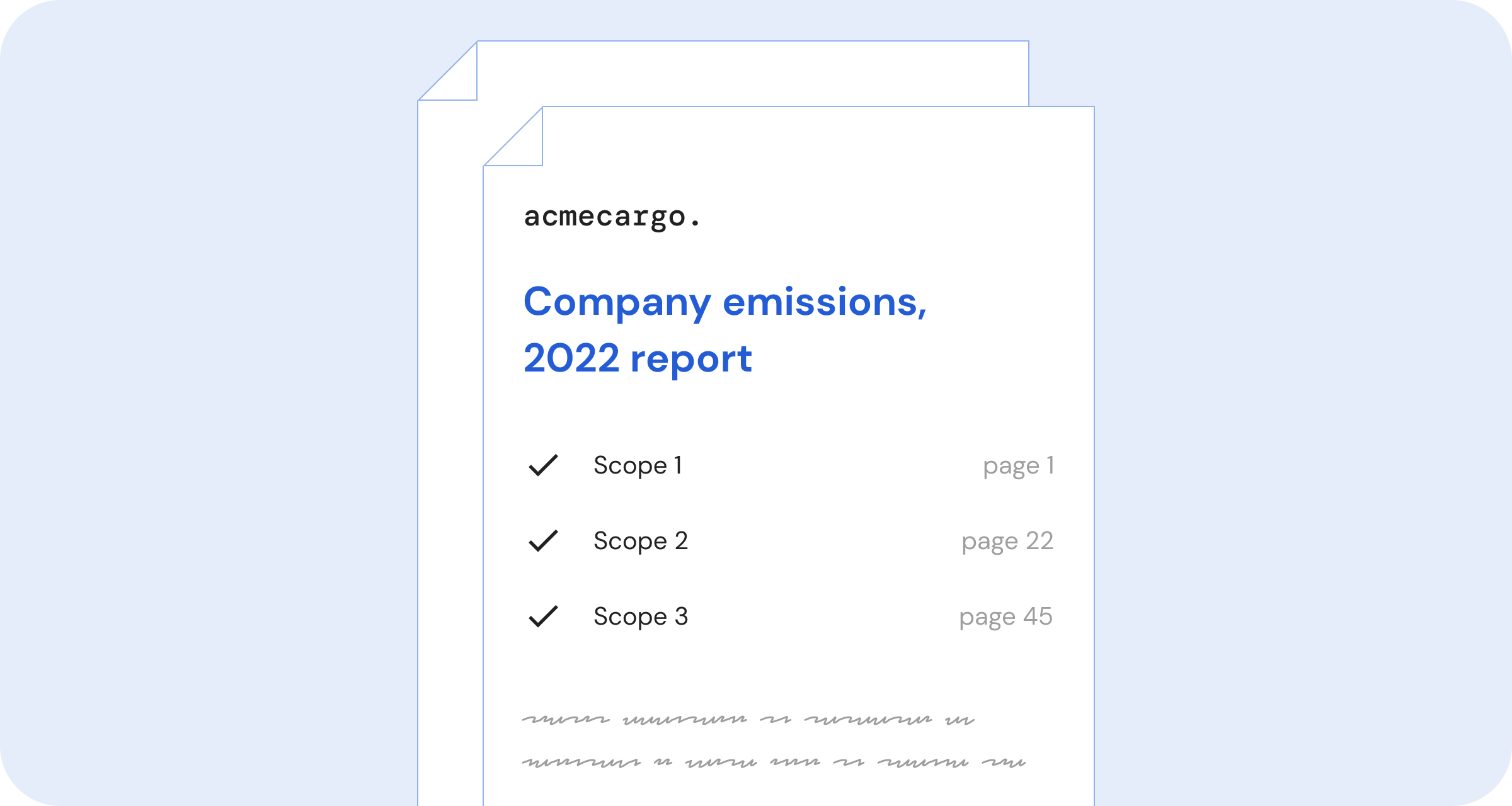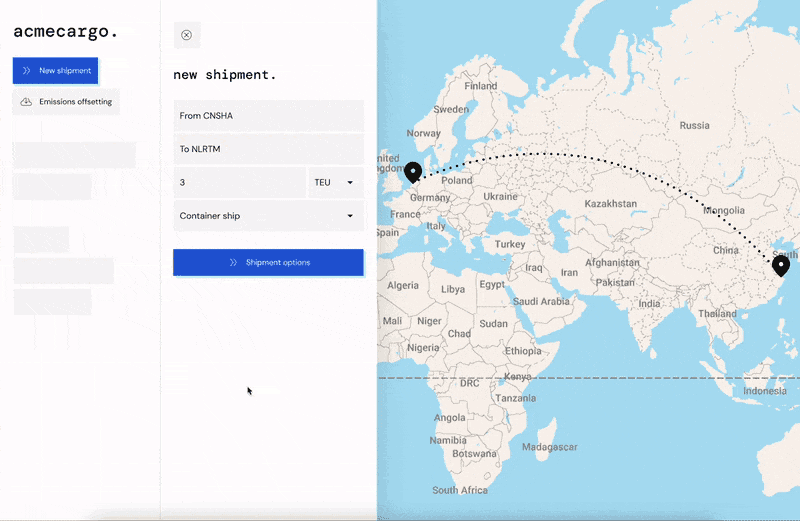

The past few months have seen two big new pieces of legislation on climate disclosure and reporting for businesses: the EU Corporate Sustainability Reporting Directive (CSRD) and the US SEC climate disclosure regulation.
Legislation like this was inevitable, and we’re likely to see more follow. Many countries have made commitments (sometimes legally binding ones) to climate targets and with businesses responsible for a big portion of emissions, they need to see action from companies in their jurisdictions. For an overview of current and upcoming climate-related legislation for businesses, head to our legislation overview blog.
But whilst it’s very much needed, starting a company’s climate journey – or adapting an existing one to fit new legislation – is never an easy task.
For a logistics business it can be particularly complex.
Logistics companies are deeply involved in the inherently emissions-heavy activity of transporting goods for other businesses.
All of the emissions from that transportation are scope 3 (indirect) emissions for the logistics sector. For a long time there’s been debate about how we determine responsibility for those scope 3 emissions, and how businesses should deal with them. With the introduction of both the EU Corporate Sustainability Reporting Directive and the SEC climate disclosure regulation, it’s highly likely that companies will be required to report on scope 1, 2, and 3 emissions.
This has big implications for all businesses, but there’s a particularly important additional consideration for logistics companies.
In this post we’ll cover the key details you need to know about the EU Corporate Sustainability Reporting Directive and the SEC climate disclosure regulation, what the implications of this upcoming legislation is for logistics companies, and what businesses can do to get prepared ahead of sustainability reporting legislation like this coming into effect.
This will have big implications for logistics companies – here’s everything you need to know.
The EU Corporate Sustainability Reporting Directive (CSRD)
In June 2022 the European Parliament approved new legislation, the Corporate Sustainability Reporting Directive (CSRD), replacing the 2017 Non-Financial Reporting Directive.
The important information:
- What is the CSRD? Under the CSRD, companies will be obliged to prepare and submit annual reports on their environmental impact from 2024 onwards (for the 2023 fiscal year’s environmental performance).
- Who does the CSRD apply to? All large companies in an EU member state – meaning companies that meet two of the following criteria: €40 million in net turnover, €20 million on the balance sheet, 250+ employees – and all companies listed on the European stock exchange (apart from micro-companies). This represents around 50,000 companies reporting on their sustainability actions – compared to 11,700 under the current Non-Financial Reporting Directive.
- What will reports need to include? The reporting will need to meet new EU Sustainability Reporting Standards, which are currently being developed by the European Financial Reporting Advisory Group (EFRAG). But, based on early drafts, it will likely include: analysis of the risks and opportunities of climate change and how they are being taken into account in business plans, governance and management of sustainability, measurement of GHG emissions across Scopes 1, 2, and 3, targets for emissions reductions and progress towards these targets, disclosure of offsets and carbon removals.
- Why is it being implemented? The CSRD aims to increase business climate action and the transparency and accuracy of environmental reporting by businesses (thus also reducing corporate greenwashing) – achieved through mandatory reporting against standardised requirements and third-party auditing.
More information will be published running up to the launch of the CSRD, so keep an eye on the European Commission’s CSRD webpage – and make sure you’re subscribed to our monthly newsletter too, we’ll share digestible updates as and when they arise.
Subscribe for the latest insights into driving climate positivity
SEC climate disclosure regulation
In March 2022 the US Security and Exchange Commission (SEC) proposed rule changes on climate-related disclosure.
The important information:
- What would the proposed rule include? The proposed rule would require three categories of climate-related disclosures by businesses: 1) climate risks/impacts and proposed management, 2) scope 1, 2, and 3 emission measurements (third-party audited for verification), 3) targets and plans to achieve them, including information on the use of offsets.
- Who would be affected? It would apply to all companies registered with the SEC i.e. all publicly traded companies operating in the US (both US companies and foreign private issuers).
- When would the rule come into effect? The rule would come into effect for the fiscal year 2023, with the first reports due to be filed in 2024 – but smaller companies would have a yearlong grace period, being required to file their first report in 2025.
- Why is it being implemented? The proposal is driven by the need for companies to take responsibility for their climate impact, and to provide sustainability information for investors. SEC chair Gary Gensler said: “it would provide investors with consistent, comparable, and decision-useful information for making their investment decisions, and it would provide consistent and clear reporting obligations for issuers.”
Again, there will be more information to follow, so we’d recommend checking the SEC website regularly.
What are the implications for logistics companies?
For logistics companies, there’s another big consideration to make – your customers.
In logistics, you provide other businesses with the service of transporting goods safely and efficiently to end-consumers.
For most businesses, the transportation and distribution of goods is classified as a scope 3 emission: any transportation or distribution done by company-owned vehicles would be scope 1 (direct emissions which the company itself is responsible for), but if transportation or distribution of goods to customers is done by an external logistics supplier, they would be scope 3 emissions.
And with businesses across the globe being required to report on and reduce their scope 3 emissions, you can expect your customers to be coming to you as their supplier asking for information on emissions from transporting their goods.
That means:
- Measurement and reporting: as well as measuring your company’s scope 1, 2, and 3 emissions for your own sustainability reporting, you’ll also need to provide your customers with information for their reporting – meaning you’ll need to be able to drill down into the emissions of particular customers and product journeys to provide accurate information.
- Emissions reductions: for most businesses, scope 3 emissions are the vast majority of the carbon footprint, and transportation is a big part of that. So when your customers look at making reductions to their emissions, they’re also going to be coming to you to find out what can be done. This brings business risk, because if you’re unable to offer sustainable logistics solutions, your customers will start looking at other suppliers. At the same time, it’s also a huge opportunity to win new customers through climate-friendly logistics options – efficient route planning, lower impact transport options, automated emissions calculations for route and transport type, credible offsetting for product journeys etc. Digital logistics and freight forwarder Forto, for instance, has already seen huge uptake of their sustainable options, even before legislation like this comes into force.
It’s a lot to consider and implement, and we know there’s been concern in the logistics sector about the time and resources needed to provide supply chain emissions data to customers.
The good news is that there are ways to make it easier, more efficient, and quicker to implement – such as integrating automated calculations and climate-friendly journey options into your existing logistics platform.

How else should businesses prepare?
We’d recommend every business – including those in the logistics space – prioritise their sustainability journey sooner rather than later to get ahead and ensure the legislation isn’t disruptive to business when it does come into effect.
There are plenty of actions to get started with to put you in good stead for the changes:
- Calculate your existing scope 1, 2, and 3 emissions – always using a rigorous approach for accuracy, such as the GLEC Framework
- Set targets and KPIs to reduce emissions as much as possible
- Buy high-quality offsets to compensate for emissions you’re unable to reduce (or that need long-term work to reduce)
- Identify climate risks to your business, and put mitigation measures in place
- Explore climate opportunities – how could your business respond to climate change beyond your own carbon footprint? E.g. new low-carbon products, or bringing automated climate impact into existing customer experiences.
Developing a sustainability strategy which lays out your approach and goals is always a good place to start – making sure you have a clear plan which everyone at the company is on board with and understands how their role contributes.
For support with developing a sustainability strategy with real impact take a look at our previous articles:
Subscribe for the latest insights into driving climate positivity
Readers also liked
Readers also liked

Subscribe for emissions intelligence insights
Get the latest updates in the world of carbon tracking, accounting, reporting, and offsetting direct to your inbox.


